
The Maltese Falcon of Guitars
MODEL: New Yorker Cutaway Special, “The Teardrop”
BUILDER: D’Angelico, 1957
TYPE: Archtop Acoustic
OF NOTE: Not only the most unusual guitar D’Angelico made, but also the fanciest, with its teardrop pickguard, curved bridge with the downward point, and six-ply binding • Extended fretboard on the treble side

One day a local guitarist named Peter Girardi (“PG” on the headstock) walked into John D’Angelico’s shop on the Lower East Side and asked him to build an instrument that would make his nightclub audiences really take notice. D’Angelico came up with an idea to extend the lower body in what he called a “can opener” shape. Years later, after hearing stories about this magical, mythical instrument, the collector Scott Chinery tracked it down—it had resurfaced at a Staten Island guitar store. Chinery scooped it up for the bargain price of $150,000 (he was offered $250,000 for it the very next day). But what really struck him, beyond the singular beauty of the guitar, was how the “teardrop” opened up the sound, creating one of the most powerful archtops he had ever played.
It Will, It Will Rock You
MODEL: Red Special, aka “The Old Lady”
BUILDER: Brian and Harold May, 1963–1965
TYPE: Semi-Solid-Body Electric
OF NOTE: Everything about this guitar is unique—the neck is made of wood from a fireplace mantel, buttons are used for the fret markers, the tremolo arm is fashioned out of a saddlebag holder and capped with a piece of a plastic knitting needle • Original handmade pickups were quickly replaced by a set of Burns Tri-Sonics • A “Brian May Back to the Light” promotional sixpence was added to the headstock
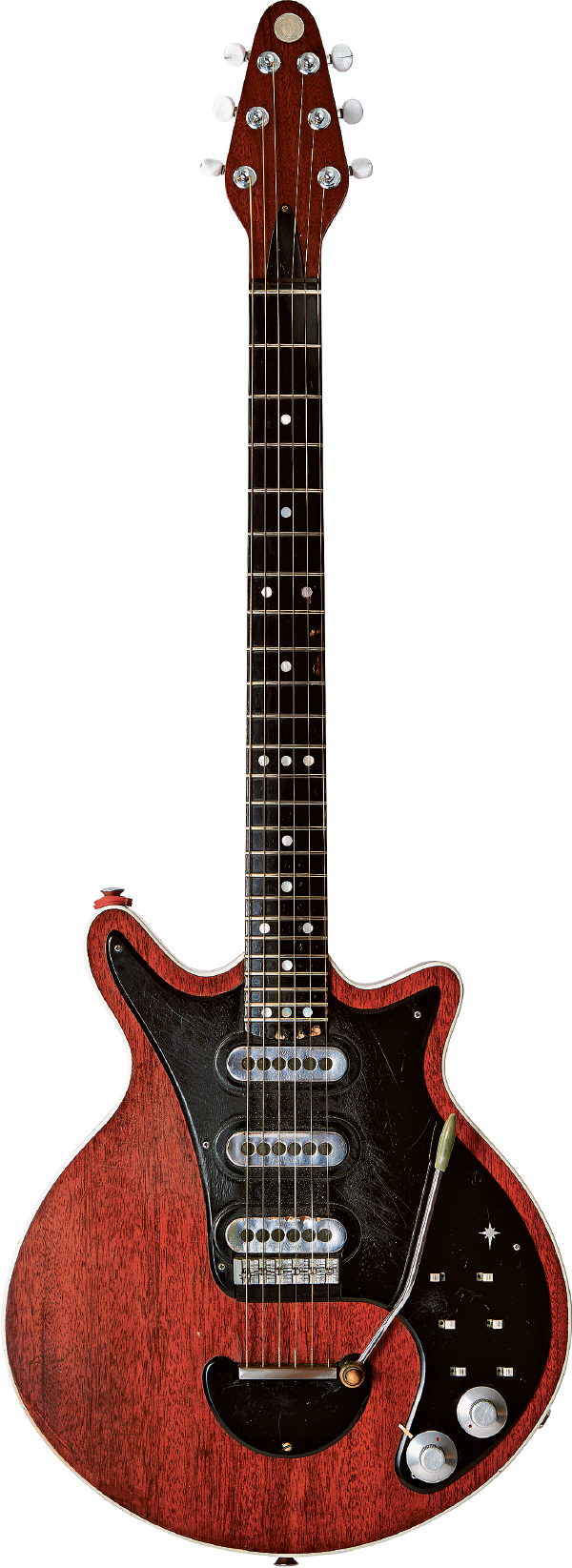
The story of Brian May’s Red Special is a rock legend in its own right: an aspiring teenage musician who wanted a proper electric guitar that would “speak to him” . . . a family that couldn’t afford to buy one . . . an engineer father who could build anything . . . and a brilliant son who was cruising toward a PhD in astrophysics before meeting a guy named Freddie Mercury. And though created out of makeshift materials found around the house, the fruit of this two-year project is a sophisticated, forward-looking, long-lived guitar as good as, if not better than, anything available commercially. The tremolo alone, built out of a knife-edge and valve springs from a 1928 motorcycle, is a work of genius. The Red Special is an unwavering presence in the life of its owner’s music—it’s been May’s go-to guitar for virtually his entire career. On tour, it has its own bodyguard. Anyway, you know the sound—it’s a guitar that speaks to lots of us.
Faux Frankenstrat
MODEL: Kramer Custom Graphic
BUILDER: Kramer, 1984
TYPE: Solid-Body Electric
OF NOTE: Built by Kramer, owned by Van Halen • A very well-used neck • Not visible: Among Eddie Van Halen’s idiosyncrasies, he boils his strings before using them

One of the most famous modern guitars is Eddie Van Halen’s “Frankenstrat.” Like Dr. Frankenstein creating the monster, Van Halen brought together different body parts—a factory-second ash body, a maple neck, a Fender tremolo system (later upgraded to a Floyd Rose), a PAF humbucker—and voilà: the Gibson sound grafted onto a Fender body. Originally painted black, then streaked with masking tape and painted white for its dynamic look, the guitar went through many iterations until arriving at this iconic red with black-and-white stripes. Kramer started building faithful versions of the guitar for Eddie, like this one, in 1984.

Robert Johnson
1911–1938
With his gutsy songs, keening voice, and mastery of the blues idiom—tight riffs and propulsive rhythms, slides, bends, and turnarounds, open tunings and repeated motifs—this quintessential Delta guitarist would influence everyone from Elvis Presley to Eric Clapton to the Rolling Stones and Led Zeppelin. What also set Johnson apart is the mystery: He is the man who in legend went to the crossroads and sold his soul to the devil in order to play the guitar. He also had the unnerving gift of hearing a piece of music just once and later being able to play and sing it perfectly.
Blues Machine
MODEL: L-1
BUILDER: Gibson, c. 1928
TYPE: Flattop Acoustic
OF NOTE: Distinctive rounded lower bout • Lack of a pickguard • Not visible: lack of a truss rod and a crude system of cross bracing whose main job seems to have been to keep the top from falling off
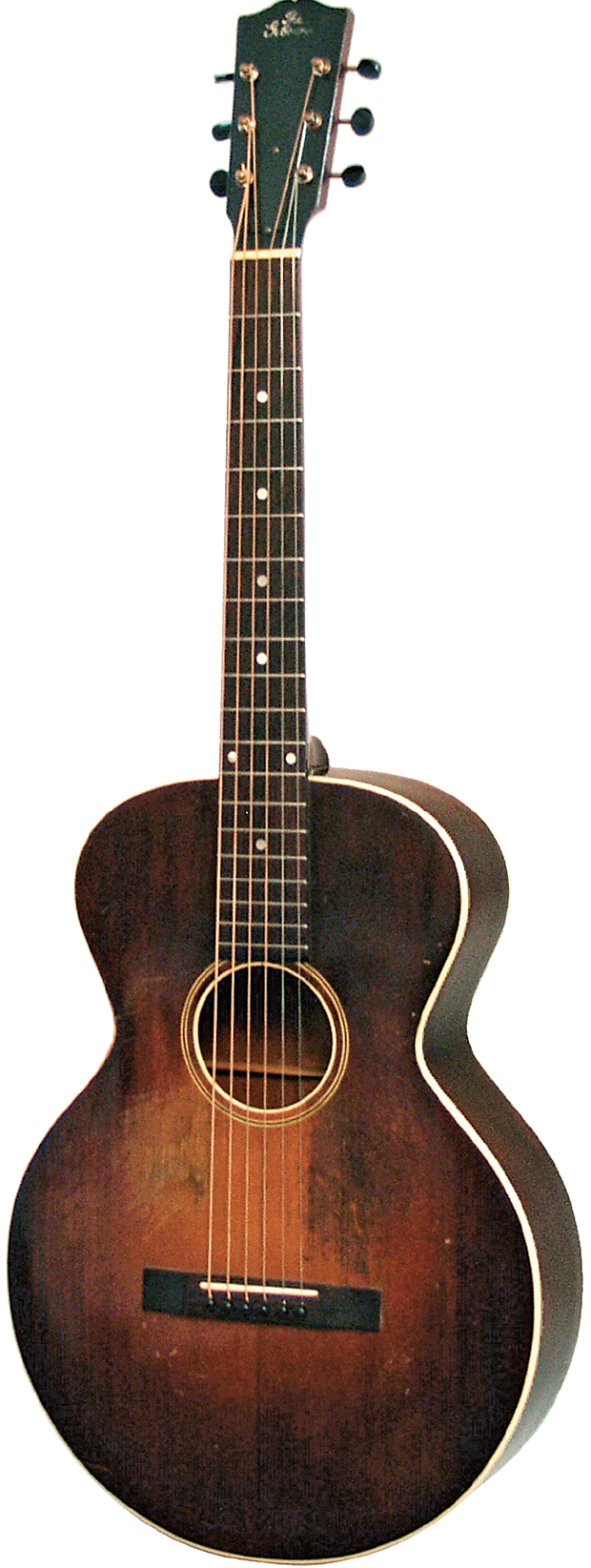
In 1925, Gibson discontinued its small-bodied L-1 archtop, then a year later reused the same designation to launch its flattop business with three affordable small-bodied guitars. These were the L-1 (pictured), the even cheaper L-0, and, a few years later, the 14-fret L-00. Gibson didn’t get serious about its flattops until a few years later, when it launched the Nick Lucas (see here). Still, history played a hand too—in one of the only two known photographs of legendary blues player Robert Johnson (opposite), he’s clearly seen holding an L-1, forever imbuing this little guitar with a special significance.
“As Many Strings as Possible”
MODEL: Pikasso II
BUILDER: Linda Manzer, 1995
TYPE: Flattop Acoustic
OF NOTE: Forty-two strings, four necks, two sound holes, and two ports, not visible • It took approximately 1,000 hours (two years) to build, and when all strings are tuned to concert pitch, the body is under 1,000 pounds of pressure

The guitarist Pat Metheny, a serious Manzer fan, asked her to build him a guitar “with as many strings as possible.” She came back with the Pikasso—a masterpiece in which lutherie meets sculpture. After seeing it in Metheny’s hands—and you can hear him playing it on numerous recordings, as well as see it on YouTube—the collector Scott Chinery asked Linda to make him one. Here it is, the Pikasso II. One difference: Metheny’s had numerous piezo pickups.
Smile!
MODEL: Big Red
BUILDER: Fred Carlson, 2005
TYPE: Harp Sympitar
OF NOTE: Five bass strings, six traditional guitar strings, and fifteen harp strings running along the side—plus twelve internal resonating strings that run through the neck, which are what make this instrument a “sympitar,” a word coined by Carlson for his design, that gives guitars the shimmering sound of a sitar too

Fred Carlson is an inventive West Coast luthier who thinks like a sculptor, which is not hard to imagine when looking at Big Red, a harp sympitar—a harp guitar with sympathetic strings. As the guitar slowly came together in his shop, its colorfulness and exuberance never failed to make him smile. And look at that psychedelic back, which is made of a one-piece shell cast from recycled paper grocery bags.
Sounding off
What makes a guitar sound like a guitar? On the one hand, it’s pretty simple. For an acoustic flattop, strings are stretched tight and anchored over a resonant wooden “box” and vibrate when plucked. The vibrations are transmitted by the bridge to the guitar top, which in turn causes the top to start moving. This thin piece of wood, usually spruce, is responsible for up to 90 percent of a guitar’s tone, presence, sustain, volume, and all the other fun words used to describe the sound of an individual note or instrument. On the other hand, it’s pretty complicated when you factor in all the construction choices that affect the sound: the type and quality of the tone woods for the top, back, and sides, the bracing pattern and types of braces, the position of the bridge, the glue used, ad infinitum.
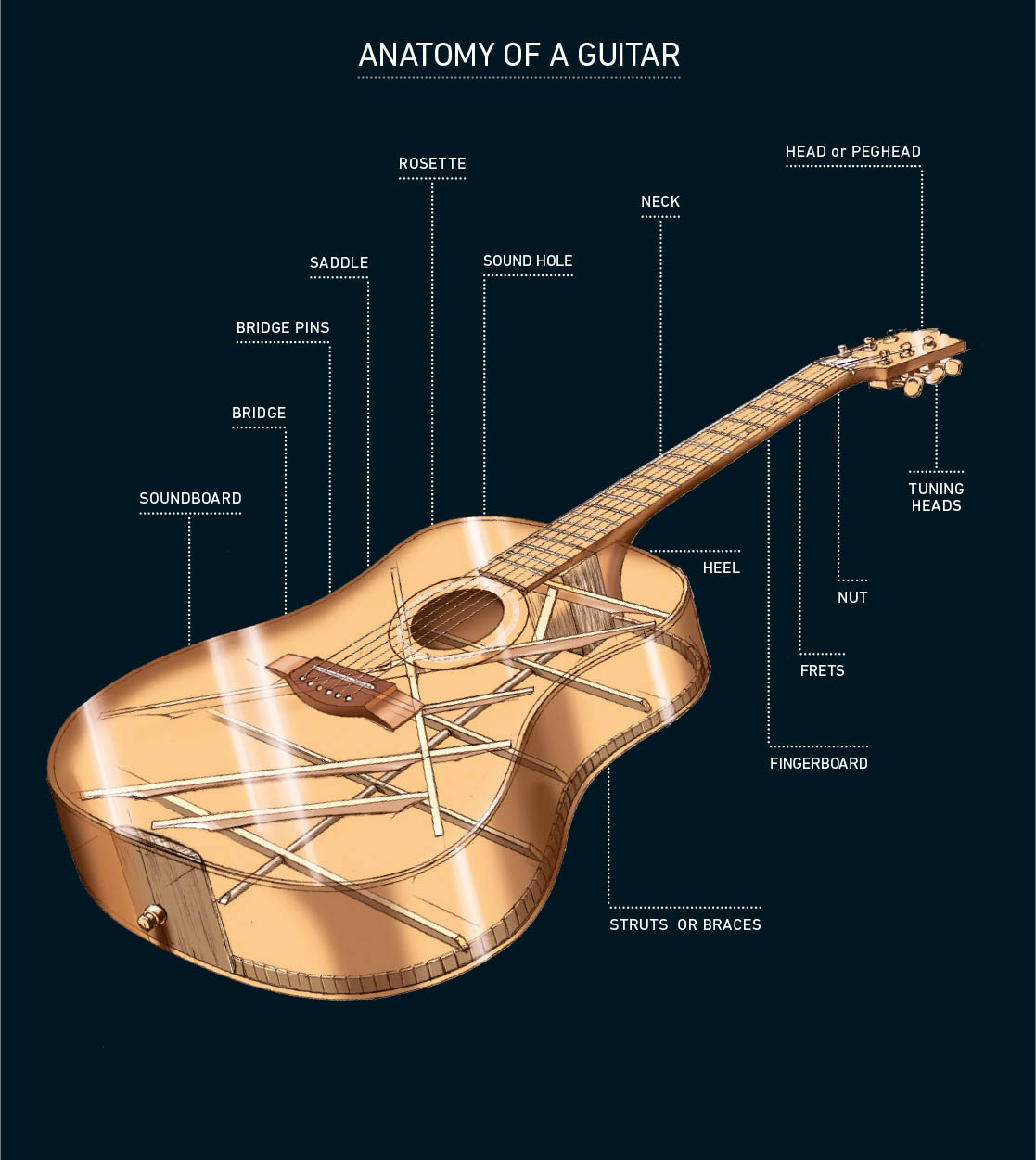
With its design adapted from the violin family, an archtop works somewhat differently. The top and back are carved out of thick boards, f-holes are traditionally used in place of a single round hole, two parallel tone bars brace the top, and the strings are not anchored but rather draped over the bridge and held by a tailpiece. When played, the soundboard moves up and down and the pressure is implosive, forcing the body in on itself.
The electric guitar, of course, derives its sound from the pickup and how the rest of the guitarist’s rig—amps and effects—processes it. The type of body (solid, hollow, semi-hollow) and wood used contribute to sustain, feedback, and some tone, but it’s really all about those little wires. Here are the basic pickups:
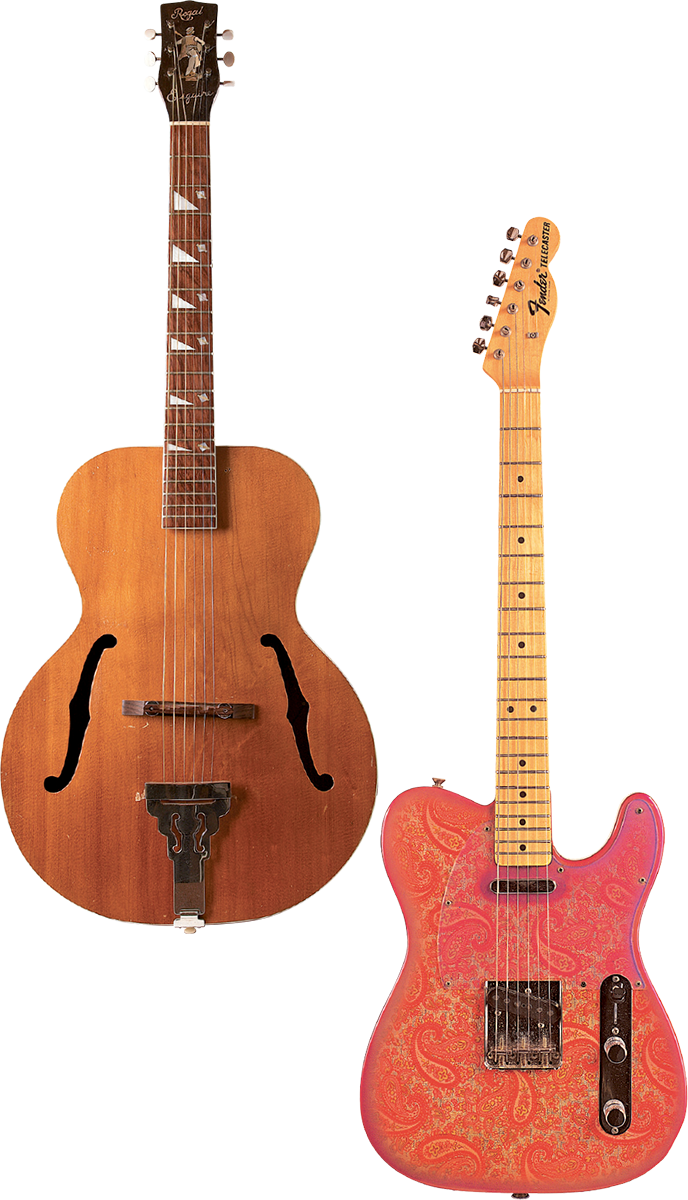
Basic Pickups
“Charlie Christian”
Introduced in the mid-1930s, this bar pickup produces a clear, powerful jazz tone, named after guitarist Charlie Christian (see here).
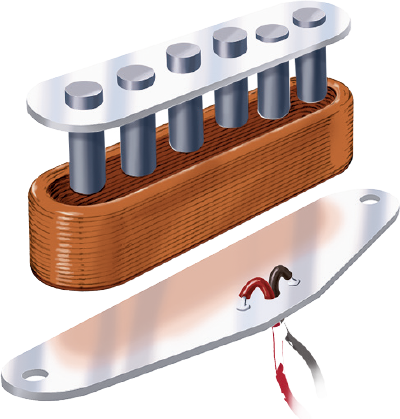
Single-coil pickup
Fender Single-Coil
Leo Fender used six magnetic pole pieces, one for each string, with a “single coil” of wire
running around them, resulting in a bright, punchy sound that can veer to “ice pick” on the treble end.
Gibson P-90
Gibson’s beefier version of the single coil, with a rich but bright sound

Humbucker pickup
Humbucker
Single-coil pickups hum—they’re like antennas, picking up disturbances and converting them into a 60-cycle hum, akanoise. In 1954, Seth Lover invented the dual-coil, noise-canceling—“buck the hum”—pickup, resulting in the darker, fatter, bluesier sound of a Les Paul.
Piezo
Piezo electric transducers use crystals or ceramic to register small changes in pressure produced by the strings. They’re mounted directly under the bridge and are used more often for acoustic guitars.
Sexy Beast
MODEL: Deluxe Steelcaster
BUILDER: Trussart, 2014
TYPE: Solid-Body Electric
OF NOTE: Body made of hollow steel, which was then allowed to rust • Retro seafoam-green-on-cream paint, weathered knobs, and a Bigsby that looks like it was recovered from a guitar from the ’50s • Engraved rose pickguard
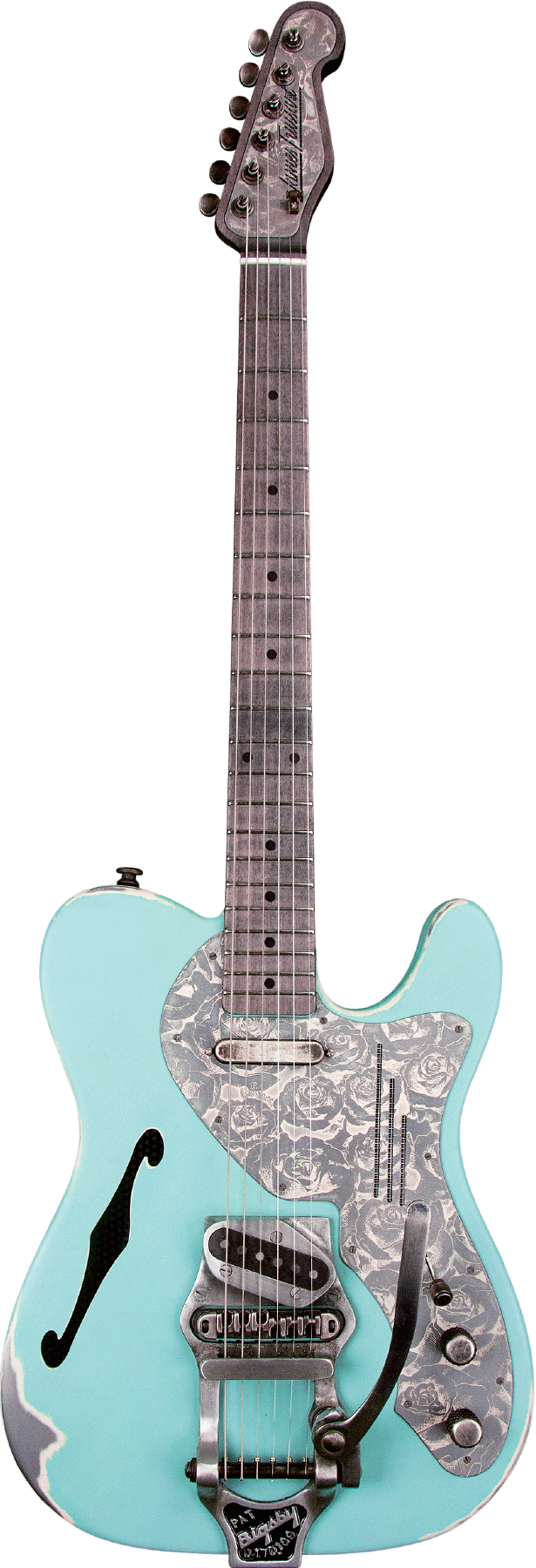
Wired magazine called the Trussart Deluxe Steelcaster a “zero-bullshit music machine.” It jumps to life in the hands, like a Telecaster on steroids—which explains why some of those Trussart-playing hands belong to a pantheon of guitarists and musicians including Keith Richards, Bob Dylan, Tom Morello, Eric Clapton, Joe Perry, Lucinda Williams, and Billy F. Gibbons, who gave Trussart guitars the nickname “Rust-O-Matics.” As for his aesthetic choices, James Trussart—a French-born musician turned LA-based luthier—says, “I wanted to make a guitar that came with a history and a slight element of neglect, of decay, so it had a personality of its own.”
Das Ax
MODEL: Melodie
BUILDER: Framus, 1965
TYPE: Solid-Body Electric
OF NOTE: Rare 9-string guitar—as if a 6-string and a 12-string had a child, with the bass side having single strings, and the treble side doubled up for the chime of a 12-string without quite so many intonation problems

Building on the need to supply instruments to aspiring West German rockers who were intoxicated with the music that GIs brought with them, German musical instrument companies like Framus were the first in Europe to start cranking out guitars. By the mid-1960s, Framus was the most successful of the group—even exporting instruments to the US. Paul McCartney’s first guitar was an f-hole Framus Zenith 17—he wrote “When I’m Sixty-Four” on it—and this Melodie is an example of the freedom that designers had even as the Fender/Gibson monolith was becoming the norm.
Separated at Birth
MODEL: N-20, “Trigger”
BUILDER: Martin, 1969
TYPE: Flattop Acoustic
OF NOTE: The “maw”—as a nylon-string classical guitar, the N-20 wasn’t intended to be played with a pick, and Nelson’s years and years of performing simply wore it out • Baldwin pickup rescued from Trigger’s predecessor • Beginning with Leon Russell, some one hundred friends and artists have signed the guitar
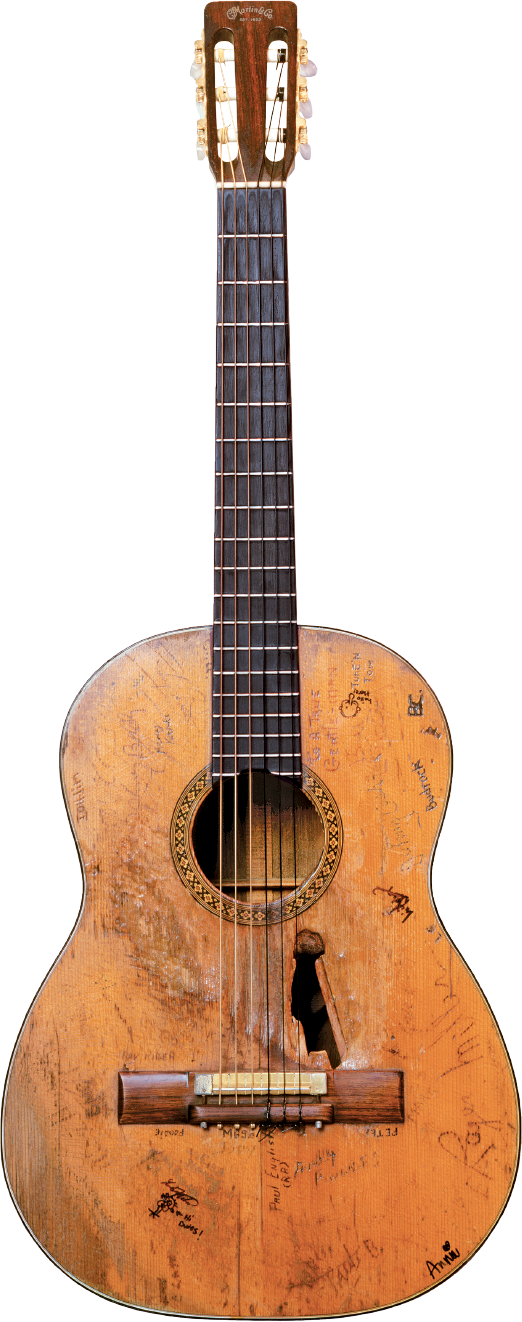
Probably no guitar in the world is as famous and beloved as Willie Nelson’s “Trigger,” a Martin N-20. The N-20 was Martin’s foray into the classical guitar market, a Spanish-style, nylon-stringed instrument. Willie bought it in 1969, sight unseen, for $750, right after a drunk stepped on and destroyed his Baldwin acoustic, and he’s been playing it exclusively ever since. Trigger has appeared in more than ten thousand shows, recording sessions, jams, and guitar pulls, and is completely inseparable from the iconic songwriter, guitarist, and singer. The name came much later: “Roy Rogers had a horse named Trigger. I figured, this is my horse!”
Banjo Killer
MODEL: D-18
BUILDER: Martin, 1942
TYPE: Flattop Acoustic
OF NOTE: Martin’s Style 18 indicates a mahogany body with spruce top and spare decoration • Whereas the big country stars had instruments custom-made with their names woven into the fretboard or body, Elvis applied his name with stick-on letters supplied by the store to customize the case
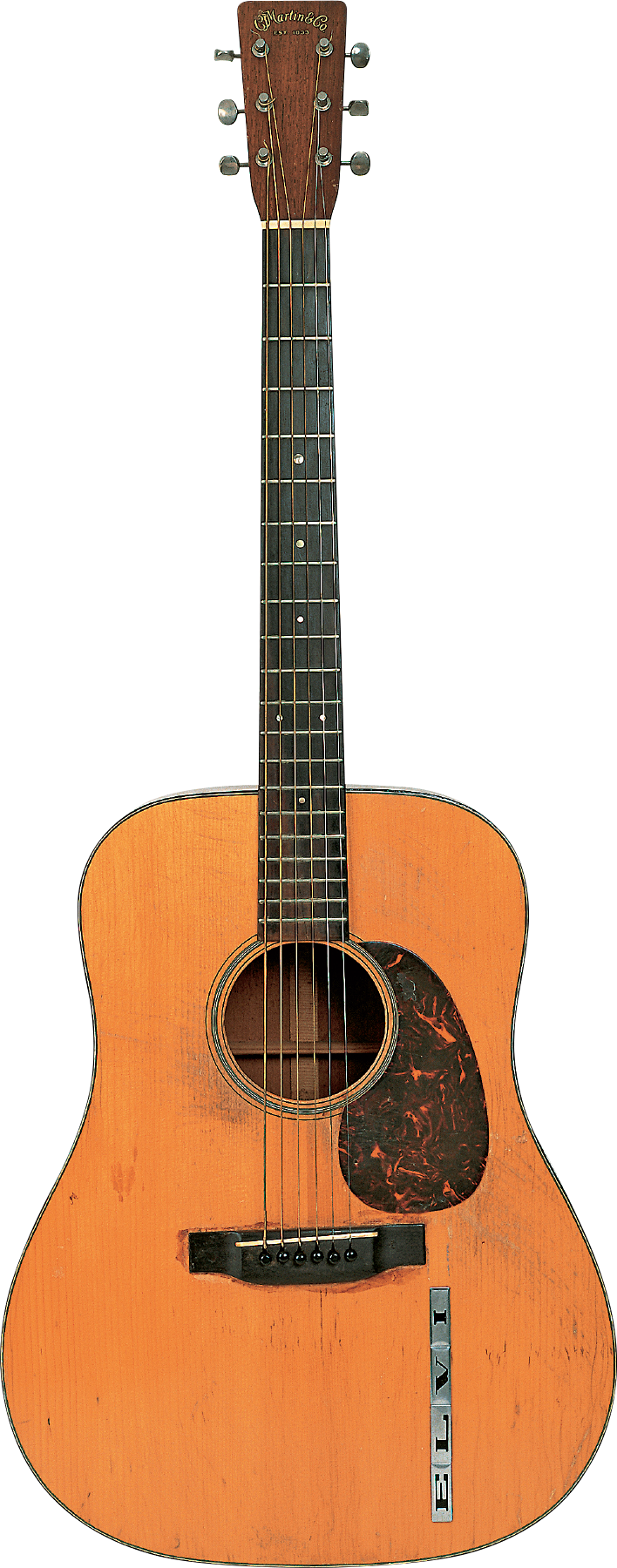
In the holy trinity of Martin prewar dreadnoughts—the 18, 28, and 45—the D-18 holds the noble position of base instrument and is one of the company’s bestselling models. Introduced as a 12-fret and converted to a 14 in 1934, it is unadorned to the point of severity—almost Shaker-like in its lack of appointments—but has a raucous, powerful voice. And with that mahogany body, nothing gets in the way of the pure delivery of tone, so dry and open it can hold its own in any group, banjos included. For Elvis it meant having a perfect beast of a guitar to play rhythm. Or, as his main guitarist, Scotty Moore, said, “he just kept beatin’ on it till we got through the set.”
Far Ahead of Its Time
MODEL: Vivi-Tone Electric Guitar
BUILDER: Vivi-Tone, c. 1933
TYPE: Solid-Body Electric
OF NOTE: Another missing link in the evolution of the solid-body “Spanish-style” electric guitar—i.e., a guitar that derives its sound entirely and exclusively from electricity • Those f-holes—they’re painted on • Not visible: beams bolted onto the flat back

Lloyd Loar was an internationally known mandolinist by the age of twenty when he came to Gibson with ideas for improving their mandolins. Gibson signed him on, and for the next five years, he blazed a path of greatness, introducing iconic instruments like an F-5 mandolin and L-5 guitar. He eventually left Gibson and in 1933 founded Vivi-Tone, where he explored his most offbeat ideas, including this visionary single-plank electric.
Don’t Sweat It
MODEL: Guitar Organ
BUILDER: Godwin, 1976
TYPE: Hollow-Body Guitorgan
OF NOTE: Sixteen mini-toggle switches for the organ, including Sustain, Percussion, Flute, Strings, Trumpet, Oboe, and more • Six “sound holes”—the “S” on the bass side, and five minis under the strings, each covered in mesh

As the electric guitar found its place and started changing popular music, guitarists (and the listeners who loved their music) began craving ever more interesting and expressive sounds. Pedals were one way to go. Another was to change the nature of the guitar itself—mate it, as in this example, with an organ. From Sisme, the Italian owner of Godwin organs, came this magnificent instrument, a hybrid guitar-organ with complicated controls. It featured wired frets divided into six segments so that contact with the individual strings completed a special circuit and opened up a world of sounds and sustain. Some have described it as sounding close to a Hammond B3 organ. But everything had to be kept pristine. A little sweat from the player, and next thing there would be crackling interference.
Uniquely Prince
MODEL: Yellow Cloud
BUILDER: Dave Rusan/Knut-Koupee Enterprises, 1989
TYPE: Solid-Body Electric
OF NOTE: All the metal hardware is gold colored, including the tuners, knobs, and nut and truss cover • Two EMG pickups, a single coil on the neck, and humbucker on the bridge • Black fret markers using the simplified Prince spade symbol

Everything about Prince was unique, as if he were born knowing exactly what he wanted to do, and had the otherworldly talent, focus, and will to make it happen. A little bit of that is reflected in his “Cloud” guitar, designed by Prince and built by a Minneapolis music shop. The first Cloud was white, and four others followed in different colors. Though particularly heavy, with bodies of rock maple, they took a beating—Prince broke the neck of this one in 1994 while on a French TV show. His techs fixed it . . . and it fetched $225,000 at auction in 2018.
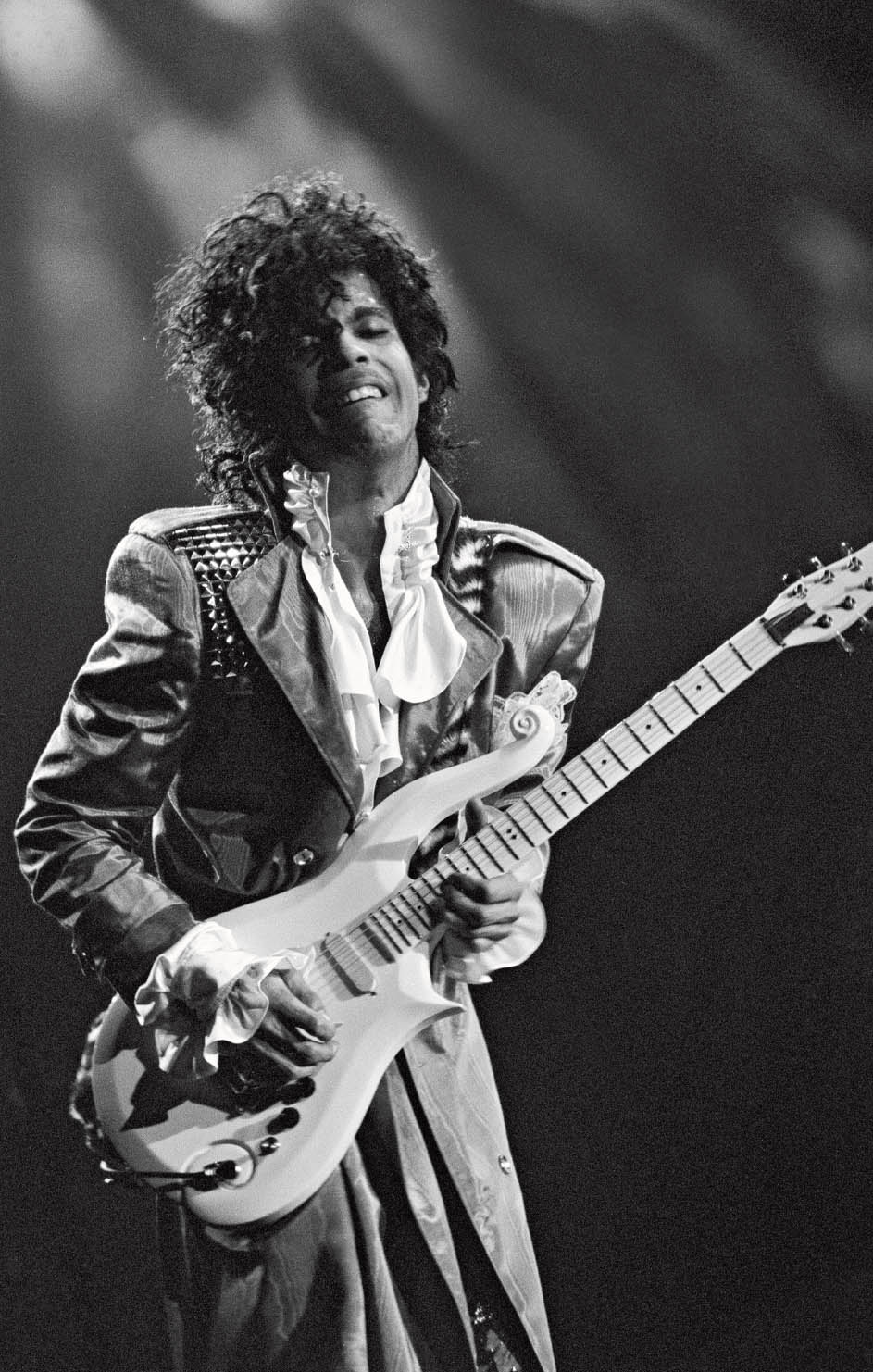
Prince
1958–2016
“Jaws on the floor” is the only way to describe the reaction to Prince’s solo on “While My Guitar Gently Weeps” during George Harrison’s induction into the Rock & Roll Hall of Fame. But the same could be said for his playing—well, his whole show, really—in the driving rain during halftime at Super Bowl XLI. Or, years and years earlier, the opening of “Why You Wanna Treat Me So Bad?” Though often compared to Hendrix, as a guitarist Prince thought of himself a little more like Santana—“prettier.” Miles Davis called him a combination of “James Brown, Jimi Hendrix, Marvin Gaye . . . and Charlie Chaplin.” Truth is, there are no words to describe Prince, including Prince as guitarist. And if you weren’t lucky enough to see him live (especially his late-night solo shows) at least there’s YouTube.
MODEL: Style O
BUILDER: Gibson, 1920
TYPE: archtop Acoustic
OF NOTE: Florentine scroll on the non-cutaway side • Extended fingerboard on the treble side • Distinctive Gibson circular lower bout

Working out of a 10'-by-12' shop in Kalamazoo, Michigan, the eccentric musical inventor Orville Gibson applied violin-making techniques to guitars, mandolins, and a variety of hybrid instruments. The crux of the matter was using a top carved into an arched shape, like a violin’s, rather than flat and heavily braced, like a typical Martin, an innovation that allowed the top to be strong and self-supporting. This Style O—“O” refers to the oval sound hole—is a direct descendant of Gibson’s original carved-top guitar, and a stylistic sibling to Gibson’s fancy F-style mandolin. The Style O lasted from its introduction in 1908–1909 until a few years after the advent of the epoch-making L-5 in 1922.
Another Country Heard From
MODEL: Opus
BUILDER: Murray Kuun, c. 2016
TYPE: Archtop Acoustic
OF NOTE: Exquisitely sculpted body, including the modified Florentine scroll and raised bout and horn on the treble side • Stenciled f-hole effect • That pickguard

Working out of a one-man shop in Johannesburg, South Africa, Murray Kuun is a luthier in the fullest sense of the word. He makes not only handcrafted, hand-carved, creatively designed jazz archtops like this blond beauty, but also classical guitars, electric guitars, mandolins (which look like miniature versions of the Opus), ukuleles, and, his first love, violins, some of which have an outrageously avant-garde design (including a bodiless one called “Future Tense”).
MODEL: Style 4 Tricone
BUILDER: National, 1928
TYPE: Resonator Acoustic
OF NOTE: Nickel-plated “German silver,” an alloy of nickel, copper, and zinc—this one, which belonged to bluesman Tampa Red, was originally gold-plated, giving him one of his nicknames, “The Man with the Gold Guitar” • The chrysanthemum design signifies National’s top-of-the-line model • Tampa Red’s name is engraved on the lower bout

George Beauchamp was a Texas-born vaudeville performer who played Hawaiian guitar in his act, and like many players of his time, he had one wish: more volume! But he also had an idea—hook up a guitar with the kind of horn used in early phonographs. He took this brainstorm to the Los Angeles–based inventor John Dopyera, who solved it by using a different part of phonograph amplification—the cone of a speaker. In 1927, Dopyera patented the three-cone configuration—three spun-metal cones in the body joined by a T-shaped bar to convey vibrations from the strings to the cones—that would give birth to the iconic resonator guitar.
Take a Bite
MODEL: Norman Forbidden Fruit
BUILDER: Paul Norman, 2005
TYPE: 12-string Resonator
OF NOTE: Snake made of lacewood, curly and burled maple, and tiger-eye eyes • Oversize headstock with apple inlay • On the upper left, “rattle” port to give more air to the body

Afreight train of an instrument—a 17-inch, 12-string resonator designed to cut through the din of the smokiest club, this Forbidden Fruit is the brainchild of self-described Renaissance man Paul Norman, who came to lutherie as a late bloomer, using all of his experience as a carpenter, architect, designer/draftsman, software engineer, and more to create this monster blues machine. Of the motif, he says: “If snakes were this loud and clear, nobody would ever get bit.”
“The Very Best Guitar Money Can Buy”
MODEL: Washburn “Bell” Style 5271
BUILDER: Lyon & Healy, c. 1929
TYPE: Flattop Acoustic
OF NOTE: Ornamentation on the top • No-name, logo-less slotted headstock • No pickguard, and a lot of scratchy wear on the treble side

Founded by Oliver Ditson, a Boston music dealer, and two of his associates, George Washburn Lyon and Patrick J. Healy, Lyon & Healy was one of the world’s largest guitar manufacturers by the late 1800s. Unlike Martin or Gibson, Lyon & Healy proudly mass-produced its guitars, many under the Washburn name, and for years offered instruments in every price range. But by the 1920s, Lyon & Healy’s reputation had started to slide—their guitars just weren’t as good as a Martin, and actually cost more. One move to counteract this downturn was the launch of the upscale Bell, a $195 guitar marketed to the player who craved the very best. The model lasted for less than four years.
Space Guitar—Literally
MODEL: Backpacker
BUILDER: Martin, early 1990s
TYPE: Flattop Acoustic
OF NOTE: Distinctive psaltery body shape • Spruce top and mahogany back and sides • Nearly full-size neck with full 111⁄16" width at the nut

It’s the guitar lover’s dilemma: You want an instrument with you wherever you go, but many times it’s just not practical. A designer named Bob McNally came up with this radically clever solution. Light yet rugged, made with real tone woods and featuring a nearly full-size neck with a 24-inch scale, the Backpacker® not only plays like one of your guitars at home, but also produces a pretty good tone—perfect for a sing-along on the beach or around the campfire. In the quarter century since Martin introduced the Backpacker, it’s been carried and played just about everywhere, from the space shuttle to base camp on Mount Everest to both the North and South Poles.

Joni Mitchell
1943–
A masterful singer, a peerless songwriter, composer, painter, and innovator: All describe Joni Mitchell. But she is also a highly original guitarist who truly thinks outside the box in her approach to the instrument. As a child, she taught herself to play the guitar through a Pete Seeger tutorial, but later developed her own idiosyncratic system, fiddling for hours with the tuning pegs until finding a sound—what she called her “weird chords”—that matched her mood. This resulted in her using some fifty different nonstandard tunings in writing her songs.
The Power of Pure Bone
MODEL: D-28
BUILDER: Martin, 1941
TYPE: Flattop Acoustic
OF NOTE: The D-28 was introduced in 1931—this instrument, built in 1941, with a Brazilian rosewood body and Adirondack spruce top, is the last of the highly covetable prewar D-28s, as World War II irrevocably forced changes in materials and production • That subtle yet so meaningful herringbone—“bone”—trim

In 1916, Martin built the first dreadnought, a big-bodied guitar fancifully named after a German battleship, in collaboration with the guitar department at the New York outpost of Oliver Ditson & Co. Martin made them for a number of years, though the model mostly languished. Then in the early 1930s, Martin dusted off its original paper pattern to meet the same recurring need—how to produce a powerful, versatile flattop with sufficient volume and the deep, bassy tone that is so well suited to vocal accompaniment. It worked.
100% Attention, 100% of the Time
MODEL: Because of Constance
BUILDER: William “Grit” Laskin, 2017
TYPE: Flamenco Guitar
OF NOTE: The quote on the body is directly from a letter that artist Frederick Varley wrote—“Oh if it were only possible for you people to know what it was like”—which Laskin equates to the way Woody Guthrie etched or wrote “This Machine Kills Fascists” on his guitars • The phrase “Or What?” on the rosette refers to the title of one of Varley’s war paintings, and is encircled by two tubes of paint of Varley’s favorite colors • Extraordinary inlay on neck and headstock illustrates scenes and interpretations of Varley’s life and work

In 2017, the McMichael Canadian Art Collection mounted a show that matched seven prominent Canadian luthiers with Canadian landscape painters from a century before, who were called the Group of Seven. Grit Laskin, renowned for his inlay work, took his inspiration from the artist Frederick Varley, who loved doing portraits and used highly expressive colors. Varley was profoundly moved by what he saw in the fields of France during World War I, which also appealed to Grit’s own strong feelings about war. Laskin, who loves doing what others are scared by, chose to make a flamenco guitar—a Flamenca Negra, made of African blackwood.
An Artist Interprets an Artist
MODEL: Arthur Lismer Guitar
BUILDER: Tony Duggan-Smith, 2017
TYPE: Archtop Acoustic
OF NOTE: Carved horn spoon tucked into the headstock, a memento from the art school where Arthur Lismer had been the principal, and Tony Duggan-Smith was a student—he likens it to Citizen Kane’s “rosebud” • The guitar has an almost mandolin-like tone, complemented by the eight harp strings within easy reach • Drawings on the harp extension piece and back of the headstock

A member of the Canadian guitar-building community that includes Linda Manzer, Sergei de Jonge, and Grit Laskin, Tony Duggan-Smith was one of the seven luthiers involved in the Group of Seven show (see opposite), and built this most unusual small-bodied instrument as his response to the landscape artist Arthur Lismer. Curiously, the luthier Tony Duggan-Smith is now spending his time custom-building “Apprehension Engines,” a musical instrument unlike any other that allows a player to create all the creepy sounds you might hear in a horror movie. He built the first for Canadian composer and musician Mark Korven, known for his work on sci-fi and horror films.
MODEL:Electro A-22 “Frying Pan”
BUILDER: Rickenbacker, 1934
TYPE: Lap Steel Electric
OF NOTE: Twin horseshoe pickups, single volume knob • Solid cast aluminum body that was originally gold enamel • Neck is scooped and the 22 frets are ridges designed for lap-steel playing •Earlier spelling of “Rickenbacher” on headstock

It may be impossible to say who developed the first electric guitar, but Rickenbacker made history by being the first to manufacture and sell it, offering the legendary lap steel “Frying Pan”—so nicknamed because of its shape—in 1932. Created by George Beauchamp, a tinkerer and guitarist who collaborated with the Dopyera brothers on the development of the resonator (see here), the Frying Pan isn’t just a museum curiosity. It was made until the 1950s and is still sought out by players for the special tonal quality that comes from a heavy horseshoe pickup and solid metal body.
Reimagining the Electric Guitar
MODEL: Birdfish
BUILDER: Teuffel, 2006
TYPE: Bodiless Electric
OF NOTE: Everything in this guitar, down to the screws, is custom-made in the Teuffel shop • The “bird” is the cast aluminum piece that holds the neck—the “fish” is the piece that holds the bridge and control box
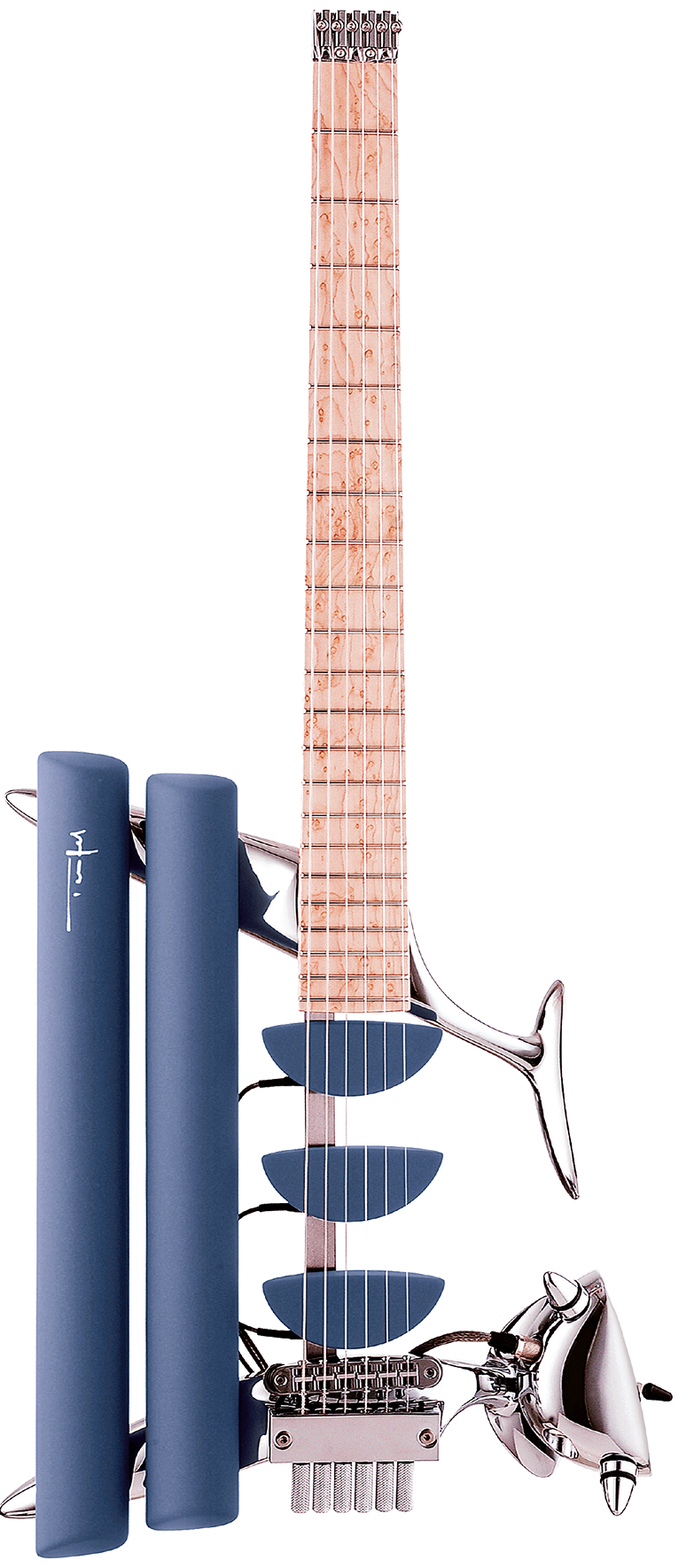
Ulrich Teuffel studied industrial design with a teacher who previously worked at Apple in the 1980s and was trained, he said, to think in concepts. His concept for the electric guitar? Understand all its constituent parts, then reimagine them in a way that allows the guitar to be fully modular. In 1995, he presented the first Birdfish, which puts an unlimited palette of tones at the player’s disposal. The two tubes on the left of the “body” are interchangeable tonebars (the instrument comes with one set made of maple and another made of alder) and the pickups—five are available, including two single coils with a vintage vibe and three humbuckers, one P-90, one PAF, one hot PAF—can be changed and placed in any position. There’s simply nothing else like it.
A Chorus of One
MODEL: Ciani 12-String
BUILDER: Ciani, 1923
TYPE: 12-String Flattop acoustic
OF NOTE: This instrument was likely made by John D’Angelico, who apprenticed with his great-uncle, Raphael Ciani, and took over the business when Ciani died • Delicate floral work on the fret markers and ornate pickguard

Pete Seeger described the 12-string guitar sound as “the clanging of the bells.” He should know: His recording of “We Shall Overcome” helped usher in the second coming of the 12-string, with its bright, chimey sound, as a preferred folk instrument. The origins of the 12-string guitar are obscure—it likely came out of Italian workshops, whose luthiers were already used to making instruments with double courses of strings, like the mandolin. And its temperament is notoriously fickle—it’s difficult to tune and, because of the extra stress caused by all those strings, prone to warpage. But what a sound! Before Seeger, the best-known players were two legends of the blues, Blind Willie McTell and Huddie “Leadbelly” Ledbetter.
That Jingle-Jangle Chiming
MODEL: 360/12
BUILDER: Rickenbacker, 1960s
TYPE: Hollow-Body Electric
OF NOTE: Innovative 12-string headstock design, with Rickenbacker’s ingenious solution of keeping six tuners where they normally are and adding a modified slot design with keys facing backward • Split chrome “toaster top” pickups

The Rickenbacker 12-string helped create “the most famous chord in all of rock and roll,” said Rolling Stone about the jarring, jangling blast George Harrison and the band played at the opening of “A Hard Day’s Night.” It’s also responsible for one of the most famous sounds in ’60s rock history—the 12-string chime that gave folk-rock its sonic personality on the Byrds’ recording of Dylan’s “Mr. Tambourine Man.” It all started in February 1964, when Rickenbacker displayed an experimental 360/12 at the Savoy Hilton hotel to tempt the Beatles as they prepared to invade America. Harrison walked away with it. P.S.: At the same time, Rickenbacker gave John Lennon a brand-new replacement for his much-used 325.
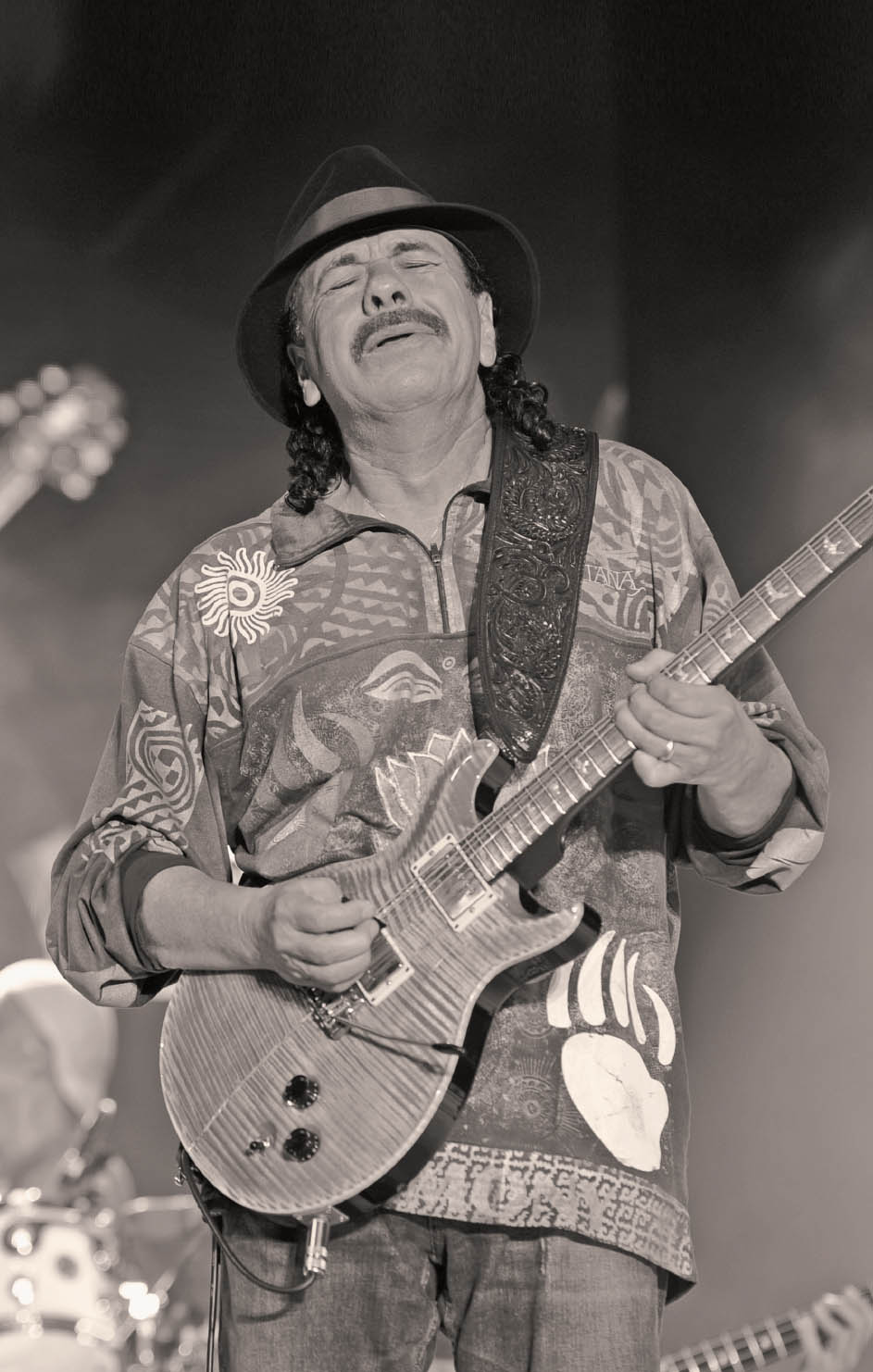
Carlos Santana
1947–
Virtually an unknown without even a record out, the Mexican-born Carlos Santana and his eponymous band from San Francisco delivered a legendary performance at Woodstock, announcing the arrival of a guitarist who would take basic blues inspiration into a world of possibilities. Over the course of Santana’s shape-shifting career, he’s explored or incorporated blues, rock, jazz, jazz fusion, salsa, African rhythms, East Indian, and classical music—and played with everyone from Booker T. Jones to Willie Nelson, John Lee Hooker to John McLaughlin, Prince to Shakira. And yet throughout, Santana’s maintained a melodic sound and an artistry so pure and distinct that, as he says, “with one note people know me.”
“The Stradivarius of the Electric Guitar”
MODEL: Santana
BUILDER: PRS, 1980
TYPE: Solid-Body Electric
OF NOTE: The famous bird fret markers were inspired by a guidebook belonging to Paul Reed Smith’s mother, a bird-watcher • Beautiful popping wood grain • In-house designed and wound pickups, and a 25-inch scale, midway between a Gibson and a Fender

More evolutionary than revolutionary, Paul Reed Smith found the middle way between Gibson and Fender to create PRS, one of the most respected and successful guitar makers in America. A sublime craftsman with a musician’s instincts, he built a guitar for his idol, Carlos Santana, early on in 1980. Santana was so impressed that he called the guitar “an act of God.” How could this nobody working out of a tiny shop in Annapolis, Maryland, create such an amazing instrument? Either Santana was a genuine skeptic, or he was steeped in the art of motivation—it took two more guitars before Santana acknowledged that these acts of God were the acts of a man creating a new American classic.
“The World’s Fastest Playing Neck”
MODEL: P46 Deluxe
BUILDER: Hagstrom, 1959
TYPE: Hollow-Body Electric
OF NOTE: Lots of accordion bling, including the sparkly plastic covering over the body, pearloid or celluloid fretboard and headstock, and control buttons • Two pairs of single-coil pickups separated by a grill—the guitar’s body was hollow,and so presumably it could function as an acoustic

Purists like Martin and originators like Fender were guitar makers from the get-go. But for so many companies, guitars were more like a product line. These companies, like Sweden’s Hagstrom, were in the music business, and when tastes changed and the business shifted, they shifted along with it. And so in 1958, as the guitar boom began booming, Hagstrom pivoted from accordions to guitars, though they brought a fair amount of their accordion sensibility—and factory full of materials—to their early instruments. By the ’60s and ’70s, Hagstrom was manufacturing dozens of different models, even hiring Jimmy D’Aquisto to design an archtop. Lots of players used Hagstroms—Kurt Cobain once had a blue version of this P46 Deluxe—though the brand got its biggest PR boost when Elvis strummed a Hagstrom Viking during the 1968 “Comeback” TV special that relaunched his career.
“A Free-Moving Sound”
MODEL: Baron
BUILDER: Domino, 1967
TYPE: Solid-Body Electric
OF NOTE: Four—count ’em, four!—pickups • Knockoff Fender Stratocaster headstock, knockoff Gibson SG body • All that chrome

Companies high and low clamored to get a piece of the guitar boom of the 1960s. One of them was the Maurice Lipsky Music Co. of New York, an importer and distributer who, circa 1967, introduced a line of Japanese-made knockoffs of models from Vox, Guild, Fender, and others. Lipsky marketed the Domino brand using the language of the times—“Lightning-Fast Action • Psychedelic Sounds • Elegant Mod Styling”—and the outlandish claim that “Today’s ‘top rockers’ know that only DOMINO can bring today’s BEST LOOKING, RICHEST SOUNDING instruments into their lives.” This candy-red, solid-body Domino Baron is a beauty, and sold for $75. Unknowable at the time, the guitar boom had actually peaked a year earlier, in 1966, and Domino, already on the fringes of guitar respectability, disappeared after one year in business.
THE FOUR SEASONS
“It started with the wood.” Inspired by a cache of very special tone woods that he had collected in his career, contemporary archtop builder par excellence John Monteleone embarked on a project in 2002 that resulted, four years later, in a quartet of extraordinary guitars. Each is different; each is designed to accompany the others; and each offers the guitarist not only a pinnacle of both design and art, including the use of rare materials like gold, silver, diamonds, and rubies, but also secret surprises. A look into the side sound holes reveals the seasonal theme of each instrument continuing on the guitar’s interior, with engraved scenes like leaves blowing off a bare tree in Autumn and a shining sun with a sailboat in Summer. Fittingly, the four guitars were unveiled at the Metropolitan Museum of Art for a show on lutherie.

SPRING
Tyrolean spruce top, red tiger maple back and sides • Six small unusual sound holes • White to light blue sunburst • Inlays with red abalone shell, turquoise, and diamond

SUMMER
Tyrolean spruce top, big leaf maple back and sides • Mandolin-style scroll on bass bout • Yellow to red sunburst • Ruby position markers on the side of the fretboard
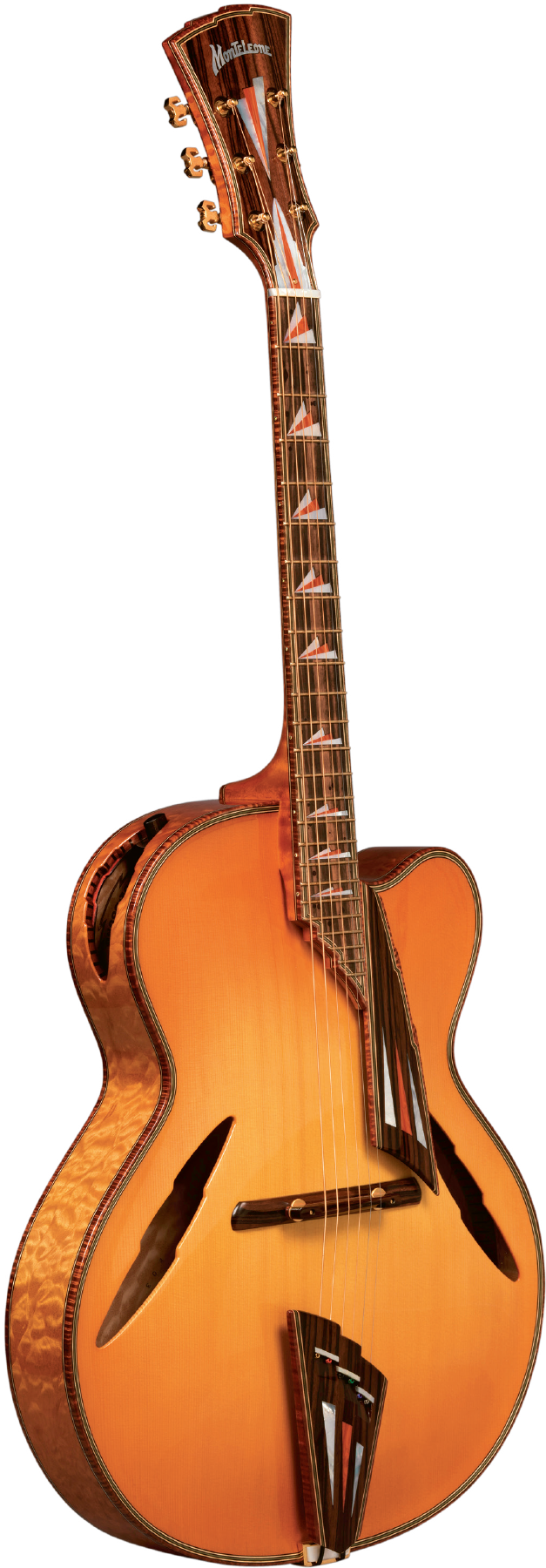
Autumn
Tyrolean spruce top, quilted big leaf maple back and sides • Elliptical sound holes, serrated to resemble autumn leaves • Lots of autumnal golds and reds, includes yellow gemstone position markers on the side of the neck

Winter
Tyrolean maple and Tyrolean spruce acquired from the workshop of James D’Aquisto • Mother-of-pearl and silver triangle position markers, with small diamonds on the side of the fretboard
MODEL: Cremona
BUILDER: Vega, 1932
TYPE: Archtop Acoustic
OF NOTE: Jarring hybrid quality—it looks like an archtop, with its f-holes, but also like a flattop, with its familiar pin bridge • Yes, those are pickguards hugging the f-holes, apparently a later addition • List price was $220, just $55 cheaper than the vastly superior Gibson L-5, making it a classic lemon

With its lovely allusion to the spirit of music—Vega is the brightest star in the constellation Lyra, which refers to the lyre of Orpheus, the legendary musician of Greek myth—Vega was the name given by two Swedish brothers to their Boston-based company. Starting at the turn of the twentieth century, Vega went through various periods of featuring either banjos over guitars or guitars over banjos, but was consistent in creating some especially beautiful and high-quality instruments. Perhaps most famous is the iconic Vega “Pete Seeger” long-neck 5-string banjo. At the start of the Depression, it got more serious about the guitar side and made this highly unusual though unsuccessful archtop.
Curious Hybrid
MODEL: Airway W2
BUILDER: Wilkanowski, 1939
TYPE: Archtop Acoustic
OF NOTE: Unique and stunning violin-shaped body • Wood binding, wood tailpiece, wood pickguard—design choices that prefigured by decades how contemporary archtop builders now work • Cat-eye f-holes that testify to Wilkanowski’s work with Gretsch
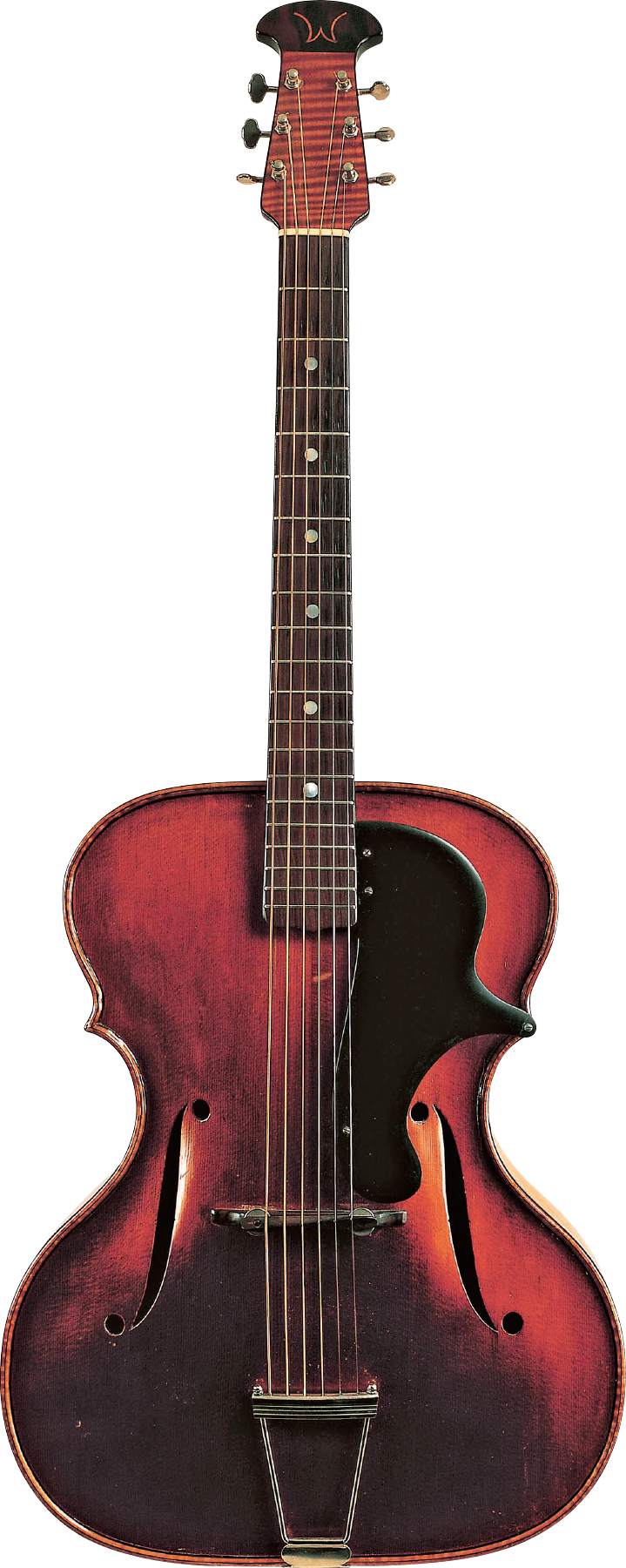
Violin construction inspired Gibson to create the first archtop guitar, but no luthier took that idea quite as far as William Wilkanowski. A native of Poland who learned to make violins as a teenager, Wilkanowski emigrated to America and ultimately built about five thousand of them, first for the Ditson company in Boston, then Gretsch in New York, and then on his own in Brooklyn, where he built violins and violas for the New York Board of Education. Then, the story goes, a friend asked him to make a guitar, and for a few brief years—from 1939 to 1941—he went on a guitar kick, building about thirty of them. Although no two models were exactly alike, this Airway has the typical cello-like points on the upper bout and the forward-looking use of wood throughout.
Artist. Scientist. Luthier.
MODEL: Berger 00-12
BUILDER: Michael Bashkin, 2018
TYPE: Flattop Acoustic
OF NOTE: Top made of moon-harvested Swiss spruce, an old practice of harvesting the tonewood during a time in the lunar cycle when sap flow is at its lowest • Ebony headstock with delicate art-deco inlay of maple lines and koa accents • Koa and ebony rosette, the pieces altered through a wood-torching process—in hot sand—that brings out different colors and figures
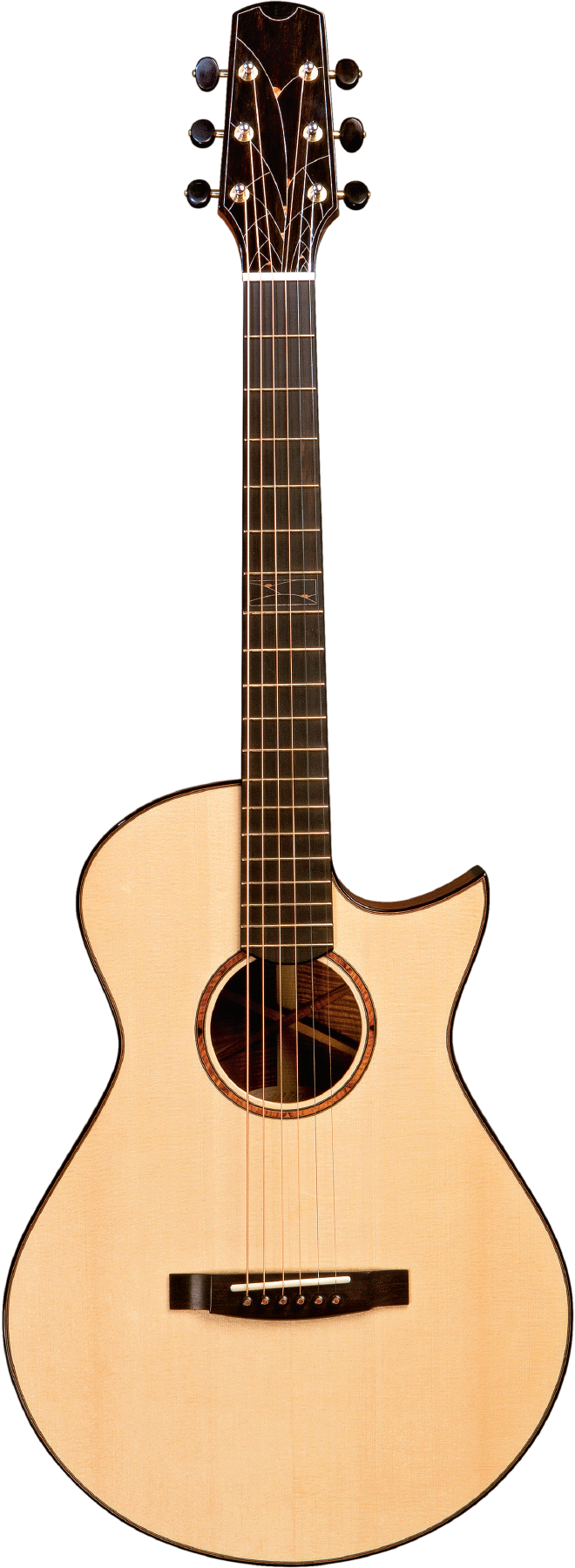
All luthiers have an intimate relationship with wood, but few have a PhD in the subject or have taught tropical forestry. Michael Bashkin brings this knowledge, along with his gifts as a visual artist and passion as a musician, to his work as a luthier, building incredibly responsive steel-string guitars with an unparalleled attention to detail. One thing about the wood—he prefers using more of it, running counter to many boutique builders who try to build as lightly as possible. He believes that it gets him what he wants to hear: an articulate, dry, vintage tone on the low end and a rich, even tone on the highs and mids, “with more information around the note.”
“I’ve Been the Student”
MODEL: Somogyi
BUILDER: Ervin Somogyi, 2003
TYPE: Flattop Acoustic
OF NOTE: “Modified dreadnought” shape—as Somogyi describes it, original dreadnoughts were designed to be strapped on and played while standing up. His is designed to be played while sitting down, with more of a waist and better center of balance

With more than fifty years of experience under his belt, Ervin Somogyi has been called a “luthier’s luthier” for both his profound knowledge of acoustic guitar construction and his wide-ranging influence on subsequent generations of builders. He built his first guitar out of a cigar box (a not uncommon beginning for both luthiers and guitarists), but most interesting is how much he attributes his skills as a builder to being an English major at Berkeley in the 1960s, which gave him the skills to look at something someone else had created, to examine it closely to discover what worked and what didn’t, and to avoid the rut of making copies of copies. He also says it’s the guitars that teach him what to do: “I’ve been the student.”
That Fat and Throaty Tone
Model: Little Sister
BUILDER: B&G
YEAR: 2018
TYPE: Semi-Hollow-Body Electric
OF NOTE: Small, noncutaway body • The soap bar P-90-style pickups, custom-built and handwound by the luthiers • A mix-and-match of old-school guitar design—slotted headstock, f-holes, brass tailpiece, nitrocellulose tobacco sunburst

The birth of innovation often begins with a simple question. In this case, how did Delta blues artists like Robert Johnson get that big, captivating tone out of a small-bodied guitar? This led designer David Weitzman on a journey that resulted in the Little Sister, a stunning “parlor electric” with a chambered body, slot-head neck, and impeccable retro appointments created by Weitzman and his friends and colleagues at B&G Guitars in Tel Aviv. A marriage of 1920s and ’30s guitar design with 1950s electronics, the Little Sister looks back in time in the right way.
A Regal Wand
MODEL: Scepter
BUILDER: Abe Rivera, c. 2000
TYPE: Solid-Body Electric
OF NOTE: Exotic woods everywhere, down to the pickguard and the knobs • German carve (or recurve) on the top, accentuated by pearl purfling • Oval brass bridge plate • Not noticeable: a 2-inch nut (for players with hands like a lumberjack’s?)

One day, luthier Abe Rivera, who hailed originally from Puerto Rico before setting up shop in Long Island, walked backstage to meet Pat Martino. Eventually he built the jazz legend a guitar that Martino dubbed the Scepter—the “regal wand.” Everything about Rivera’s guitars reflects his intense craftsmanship, feel for exotic woods, and interest in finding a tone that transcends the usual solid-body guitar, filled with the clarity, warmth, precision, and punch that comes out of the jazz archtop tradition. An attentive guitar lover will remember seeing one in the hands of Kevin Eubanks during his Tonight Show years.

Bo Diddley
1928–2008
Born Elia Otha Bates, the outrageously inventive guitarist, songwriter, and performer called Bo Diddley ranks right up there with Chuck Berry as a founding father of rock and roll. Two things marked the iconic Bo Diddley: His innovative guitars, including the Big B that Gretsch began building for him. And the Bo Diddley beat. “The mother of all riffs,” as Johnny Marr calls it, this syncopated 3-2 clave rhythm, with its roots in West Africa and the Caribbean, has a raw propulsive groove. Everyone used it; any halfway decent strummer can play it. What they might not get is another trademark of Bo Diddley’s sound, that shimmering tremolo.
Twang Machine
MODEL: “Bo Diddley” Big B
BUILDER: Gretsch, 1960
TYPE: Solid-Body Electric
OF NOTE: Iconic body and iconic color • A pair of DeArmond DynaSonic pickups • What to make of that tiny, brick-shaped pickguard?

It’s hard to imagine a guitar less elegant than this red rectangular plank, but it’s an instantly recognizable icon designed and played by the legendary Bo Diddley. According to one story, Diddley fashioned a rectangular guitar because he constructed cigar-box guitars when he was a kid, a folk craft that continues to this day. Another story claims that he created it to avoid an embarrassing injury that he once suffered—he whacked himself in the groin with the wide upper bout of a Gibson L-5 while jumping around onstage. Whatever the reason, Gretsch built this first Big B, and it became his trademark as much as the “Bo Diddley beat.”
That Bluesy Old Hound Dog
MODEL: Dobro
BUILDER: Dobro, 1970s
TYPE: Resonator Acoustic
OF NOTE: Wooden body, which harkens back to the first Dobros when the company couldn’t afford the tooling to make steel-body instruments • The resonating dish, just visible through the grill

The name Dopyera travels like a vine through twentieth-century guitar history. John Dopyera invented the original resonator guitar and founded the National String Instrument Corporation. Then, after a fight with his partners, John and his brothers founded the Dobro company in 1928—the name derives from DOpyera BROthers, and also means “good” in their native Slovak. What makes an original Dobro a Dobro is the innovation of a single forward-facing resonating cone supported by an eight-legged spider bridge that conducts the strings’ vibrations. After riding the Hawaiian music crest in the early ’30s, Dobros all but disappeared until a few country pickers kept the instruments alive, and then they were adopted in the 1970s by players like Dickey Betts and Adrian Belew. Today, Gibson owns the Dobro brand and name.
All-in-One
MODEL: Charlie Hunter Custom
BUILDER: Jeff Traugott, 2006
TYPE: Semi-Hollow-Body Electric
OF NOTE: Custom-built for phenom Charlie Hunter, who simultaneously plays lead using the top four strings and accompanies himself with bass lines on the bottom three strings • Fanned-fret system (see here) • The futuristic-looking disks are actually pickup covers
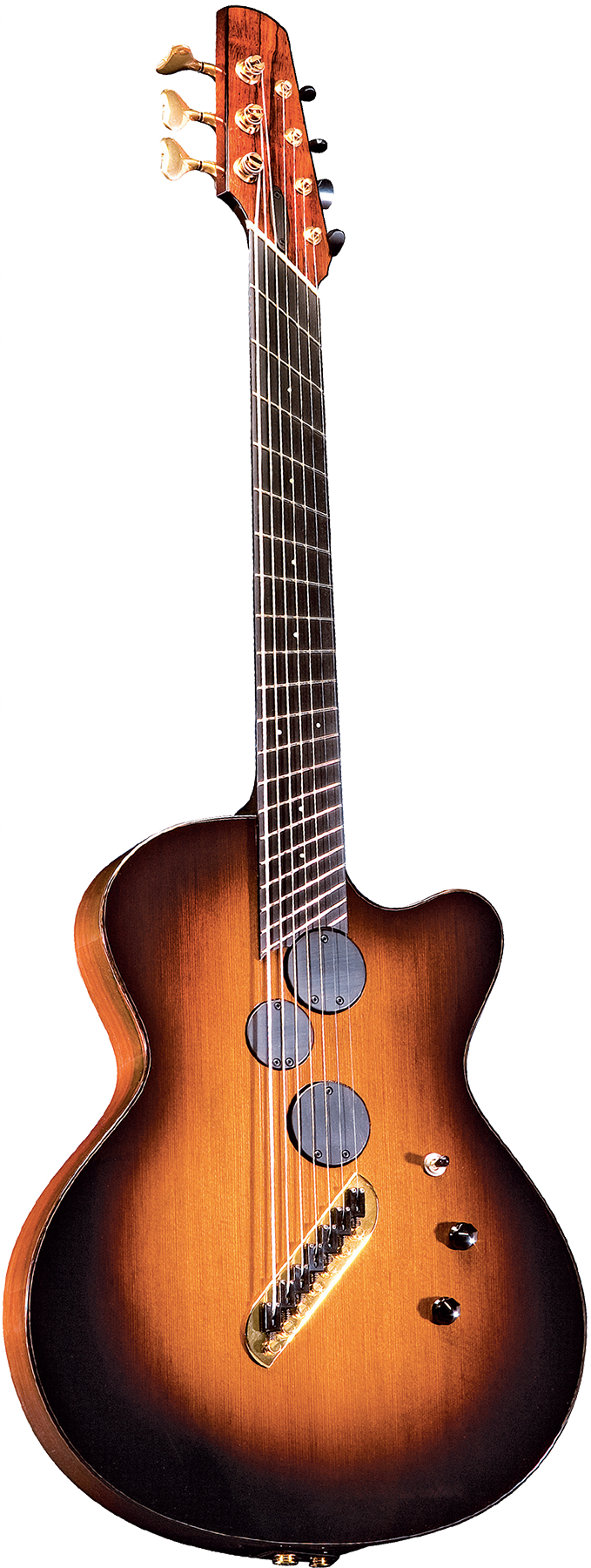
Working all by his lonesome in an old industrial building in the luthier-friendly city of Santa Cruz, California, master builder Jeff Traugott makes about a dozen instruments a year. This way, he says, he can focus on every detail—from tone and playability to the specifics of craftsmanship—as well as his relationship with the customers who are serious enough to pay serious five figures and up for an acoustic. (It should be said that in Traugott’s world, Brazilian rosewood and German spruce are entry-level choices.)
“Weissenborns Eat Dobros for Lunch”
Model: Style 4
BUILDER: Weissenborn, 1920s
TYPE: Hawaiian Acoustic
OF NOTE: Curvy, slender body tapering right into the hollow neck • The wood is koa from Hawaii, historically used to build the islands’ oceangoing canoes, as well as the occasional surfboard

In another chapter of the story of German immigrants coming to America in the nineteenth and early twentieth centuries and getting into the musical instrument business, Hermann C. Weissenborn brought his piano- and violin-making skills first to New York City and then to Los Angeles. There, he transitioned into building a line of outstanding guitars designed specifically for Hawaiian lap-steel playing, then all the rage. With a body that extends all the way to the peghead and very light build using Hawaiian koa, it produces an exceptionally warm, sweet, loud tone, and has been enjoying a renaissance among slide guitarists like David Lindley, who sized the Weissenborn up memorably next to the Dobro.
“The World’s Greatest Musical Instrument Manufacturer”
MODEL: Bohmann
BUILDER: Joseph Bohmann, c. 1910
TYPE: Archtop Acoustic
OF NOTE: Double-cutaway, domed—bent, not carved—body • Patented bridge and device that is an adjustable palm rest • Not visible: internal metal rods that vibrate sympathetically with the strings, like a harp guitar—that tiny button on the rosette is used to dampen them

When Joseph Bohmann emigrated from Bohemia to Chicago in 1873, he unabashedly declared himself the “World’s Greatest Musical Instrument Manufacturer.” He built harp guitars, violins, parlor guitars, and what some credit as the first mandolin made in America. An eager innovator as well as a skilled craftsman and natural marketer, his instruments—like this little beauty—are full of patented innovations, including the bridge and tuners. At 121/8 inches across and with its domed body, it has been described as sounding like a “parlor archtop.”
Eight Miles High
MODEL: 331, “Light Show”
BUILDER: Rickenbacker, 1964
TYPE: Semi-Hollow-Body Electric
OF NOTE: Lights behind a translucent plastic body flash in different colors according to the frequencies being played • Powered by a separate transformer that was prone to overheating, the 331 was called a “toaster with strings”
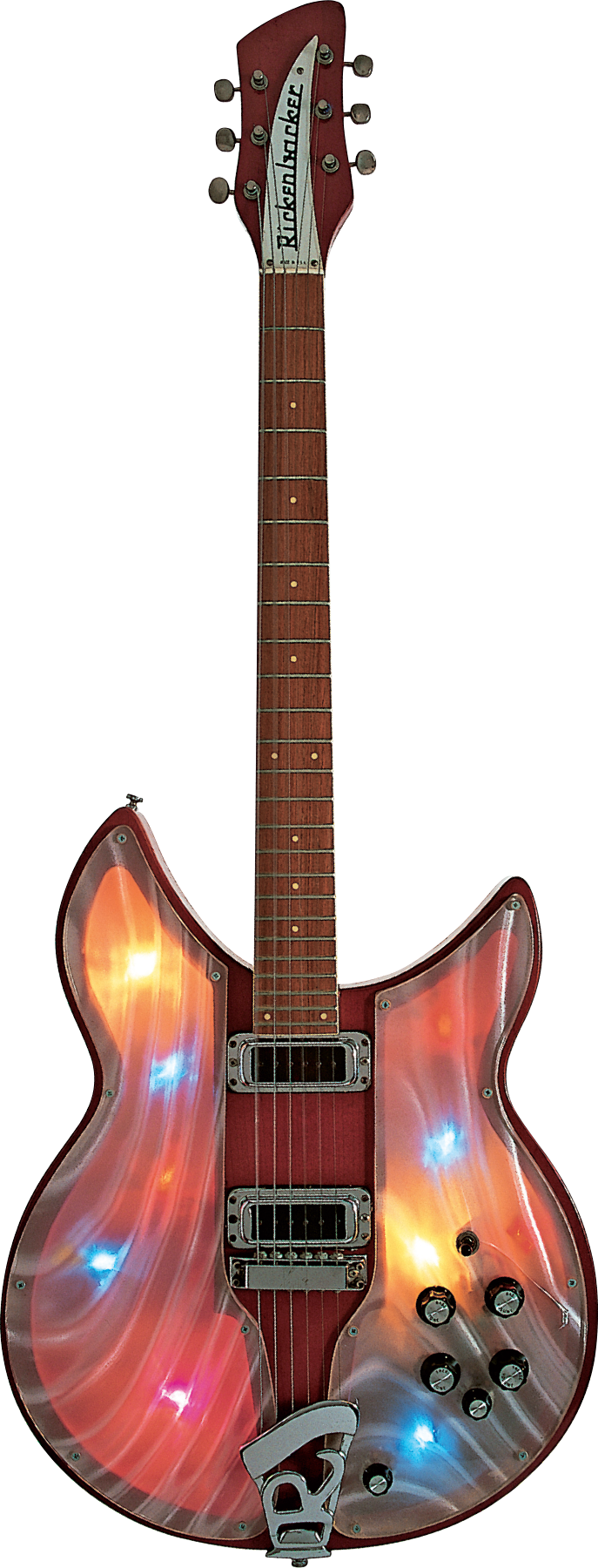
Trippy as it looks, the Rickenbacker 331 “Light Show” arrived too late for the Summer of Love. Rickenbacker introduced the guitar in 1970, inspired by stereo speakers and organs outfitted with lights that blinked and flashed in response to the music’s pitch. Though it was designed for the psychedelic movement, one of the most celebrated players who used a 331 was, ironically, Buck Owens, who loved to show his off on the program Hee Haw. Rickenbacker discontinued the guitar in 1975. If you’re curious, YouTube has a few videos of the Light Show in action.
Wired, and More
MODEL: Orbiter
BUILDER: Micro-Frets, 1968
TYPE: Semi-Hollow-Body Electric
OF NOTE: Antenna on the upper left bout to connect to FM transmitter • Calibrato vibrato, designed to keep the strings in tune • Micro-Nut, which allowed players to adjust the length of each string, a precursor by decades of tuning systems like the Buzz Feiten • Control knobs under the pickguard

There’s something about the electric guitar that appeals as much to the tinkerer as it does to the musician. A case in point is Micro-Frets, a company founded in 1967 by a self-taught inventor named Ralph J. Jones. Inspired by remote-control garage door openers, Jones offered the first cordless guitar, the Orbiter, with an antenna and FM transmitter. Other models included names like the Spacetone (Carl Perkins played one), Golden Melody, Calibra, and a guitar called a Voyager, so rare that even ex-employees had never seen one. With their oddball shapes and decades-ahead innovation—perfect for the late ’60s—Micro-Frets enjoyed a fair amount of success, all abruptly ended by Jones’s early death around 1973.
The Lloyd Loar Masterpiece
MODEL: L-5
BUILDER: Gibson, 1924
TYPE: Archtop Acoustic
OF NOTE: All the firsts: the first f-hole archtop guitar • The first modern orchestra guitar • The first guitar with a 14-fret neck to the body that had an adjustable truss rod • Gibson knew it had something special on its hands, and gave it this befitting name: “The Master Line Guitar L-5 Professional Special Concert Grand Model”

Lloyd Loar was either a musical prodigy with the mind of a scientist or a scientific pioneer with the ears of a master musician. Probably both. When the twenty-year-old, internationally known mandolinist approached Gibson, he had ideas for improving the mandolin, and Gibson wisely signed him on. For Loar, everything revolved around tone, and his true contribution was the idea that each part of the instrument—tops, backs, tonebars, even f-holes—could be “tuned” to create a more dynamic whole. With the L-5’s debut in 1922, he really broke new ground, and its uncommon marriage of aesthetics and acoustics kept it as Gibson’s top-of-the-line model for more than a decade.
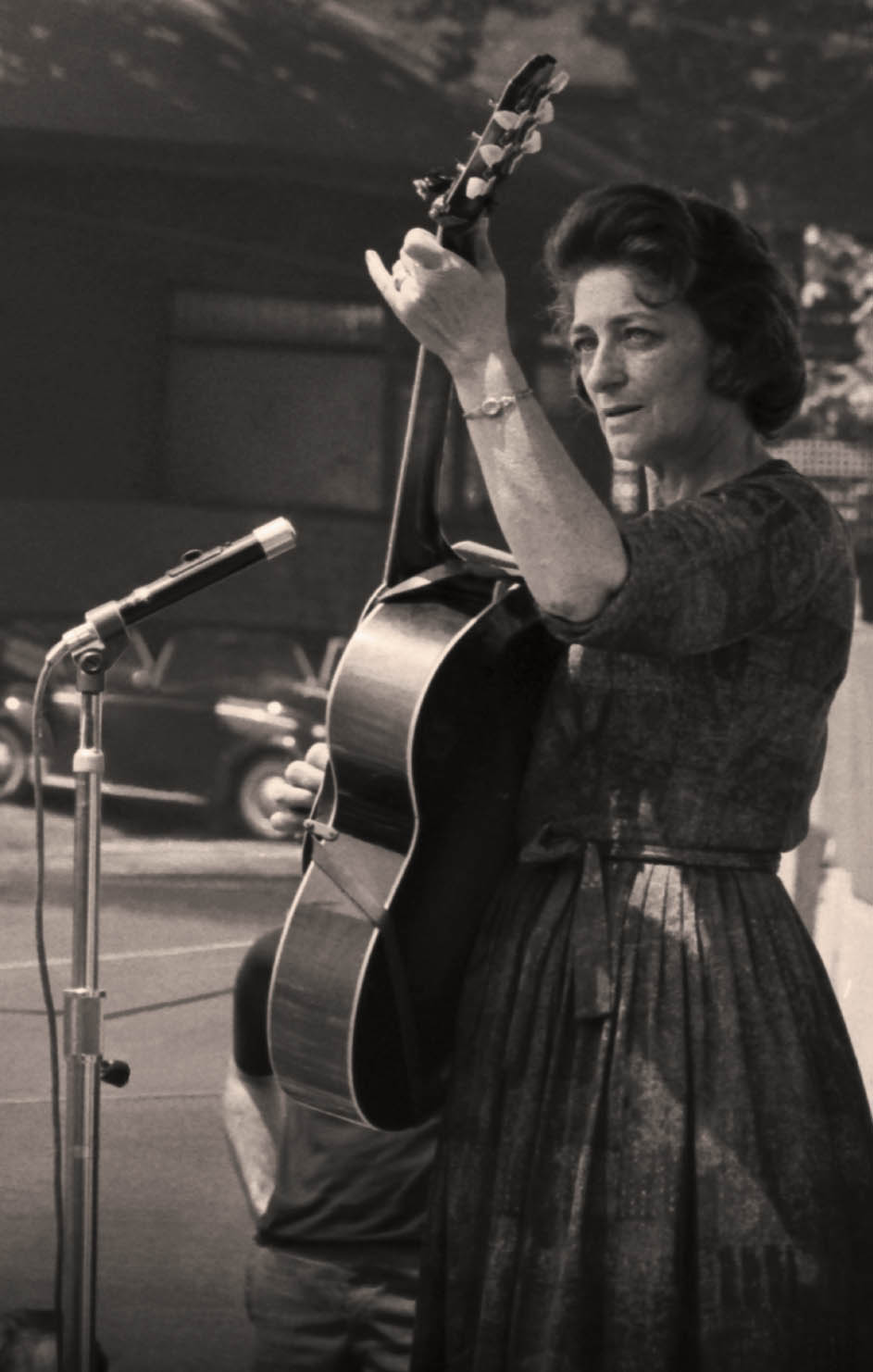
Maybelle Carter
1909–1978
To learn of “Mother Maybelle’s” adventures with The Carter Family is to realize how quickly life changed in the twentieth century. In 1927, she descended from the hollows of Appalachia to Bristol, Tennessee, where a man named Ralph Peer installed an exotic recording machine in a local hotel; forty years later, she was performing with her daughters on her son-in-law’s national TV program, The Johnny Cash Show. A self-taught musician, Maybelle Carter revolutionized country and folk guitar with her innovative style, “the Carter scratch,” a rich, bouncy technique where she plucked out the melody on her L-5 with her thumb on the bass and middle strings, and strummed the chords on the treble string.